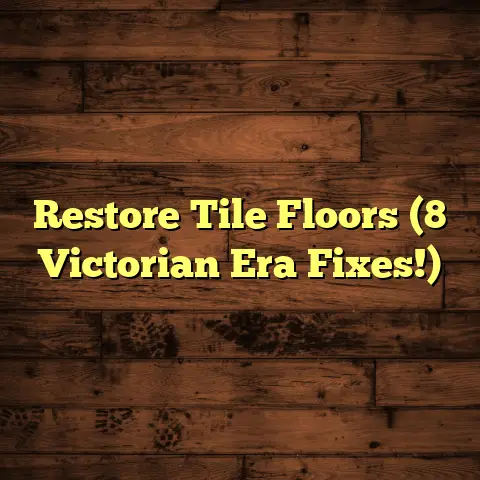How To Put Click Flooring Down? (Explained)
It’s funny how something that seems simple can turn into a real challenge.
I remember the first time I tried to put down click flooring.
I thought it would be a breeze, but it quickly transformed into an intricate puzzle, with pieces that refused to fit just right.
Today, I want to share my journey and insights on installing click flooring, hoping it will save you from some of the pitfalls I encountered.
Getting Started with Click Flooring
Selecting Your Flooring
Choosing the right click flooring is like picking a partner; you have to consider durability, aesthetic appeal, and how it fits into your space.
I’ve worked with various types of click flooring, from laminate to vinyl, and each has its unique characteristics.
For instance, when I chose laminate for a client’s living room in a bustling city area, durability was my priority.
The kids were rough on surfaces, and I needed something that could handle wear while still looking good.
On the other hand, for a serene bedroom retreat, I opted for vinyl for its softer feel and sound absorption properties.
When selecting flooring, I also pay attention to the thickness of the planks.
A thicker plank usually means better durability and comfort underfoot.
Most of my projects feature planks ranging from 8mm to 12mm thick.
While thicker options can be pricier, they often provide a more premium feel and longer lifespan.
Preparation Is Key
Before starting the installation, I learned the hard way that preparation is crucial.
- Acclimation: Let your flooring acclimate to the room’s temperature and humidity for at least 48 hours.
I once skipped this step and watched in horror as the planks expanded and contracted after installation, leading to gaps that were both unsightly and concerning. - Subfloor Check: Ensure your subfloor is clean, dry, and level.
I once found myself struggling with uneven floors, which caused a lot of headaches during installation.
A quick check saved me time later. - Tools Needed: Gather your tools beforehand.
Here’s what I usually recommend:- Tape measure
- Utility knife
- Straight edge
- Floor spacers
- Rubber mallet
- Pull bar
- Tapping block
- Level
- Circular saw or jigsaw (for cutting planks)
Having everything ready before you start makes the process much smoother.
Understanding Different Types of Click Flooring
Not all click flooring is created equal.
The variations can greatly influence your choice based on aesthetics, functionality, and budget.
- Laminate Flooring: Typically made from composite wood, laminate flooring offers durability and a variety of designs to mimic natural wood or stone.
In past projects, I’ve seen laminate hold up well in high-traffic areas; however, it’s important to note that it can be more susceptible to moisture damage compared to other options. - Vinyl Flooring: Vinyl has gained popularity for its water resistance and versatility in design.
It’s softer underfoot than laminate and can be an excellent choice for kitchens or bathrooms.
I’ve used luxury vinyl planks in several installations where moisture was a concern, and they’ve performed exceptionally well. - Engineered Wood Flooring: While engineered wood flooring may have a higher price point, its blend of real wood on top with plywood underneath provides a beautiful finish along with better moisture resistance than solid hardwood.
- Cork Flooring: This eco-friendly option is gaining traction due to its comfort underfoot and sound absorption qualities.
I’ve installed cork in a home office where quiet was a priority, and it worked wonderfully. - Carpet Tiles: While not traditional click flooring, carpet tiles offer an interesting alternative for some commercial spaces or playrooms where softness is key.
They can easily be replaced if damaged and come in various colors and patterns.
Each type has its pros and cons that need careful consideration based on the specific area where it will be installed.
The Installation Process
Now, let’s get to the good stuff—the actual installation!
Step 1: Planning the Layout
I always start by planning the layout before laying down any planks.
It’s helpful to snap a chalk line down the center of the room to guide your installation.
This approach ensures your flooring looks symmetrical and avoids awkward cuts at the edges.
In one of my projects—a long hallway—I discovered the importance of planning even more carefully.
By measuring out the layout beforehand, I avoided a situation where I had to cut narrow strips for the final row, which can look unprofessional.
Step 2: Laying the First Row
Start with the first row along your chalk line.
Make sure to leave about a ¼ inch gap from the wall using spacers.
This space allows for expansion and contraction—something I learned after a few too many miscalculations on my part.
If you’re working in a larger room or an area with multiple angles, consider using wider boards for the first row; this can help create a more visually appealing start.
Step 3: Connecting Planks
Click flooring is designed for easy installation, but it can still be tricky at times.
When connecting planks, angle one side down into the other before pressing it flat.
It took me a few tries to get this technique down smoothly.
I recommend using a tapping block during this step; it helps ensure that the planks lock together securely without damaging their edges.
A gentle tap should do the trick—too hard and you might break the locking mechanism.
Step 4: Staggering Joints
Staggering the joints not only looks nicer but also adds stability to your floor.
I usually aim for a stagger of about 6 inches between rows, which has worked well in my projects.
When you’re staggering joints, keep an eye on your row lengths to ensure they don’t line up too closely; this can weaken the overall structure of your flooring over time.
Step 5: Completing the Installation
Continue laying planks until you reach the end of the room.
For the last row, you might need to cut planks to fit.
This part can be a bit tricky, especially if you have intricate corners or obstacles.
I’ve found that using a circular saw or jigsaw makes cutting easier and cleaner than using a utility knife alone—especially when dealing with thicker planks.
Step 6: Finishing Touches
Once all the planks are down, remove the spacers and install baseboards or molding to cover the expansion gap.
It’s amazing how much these finishing details can elevate the overall look of your space.
If you’re working in tricky areas like doorways or transitions between rooms, consider using transition strips for a professional finish.
Challenges Encountered
Even with all my experience, challenges do arise.
One project sticks in my mind: installing click flooring in a kitchen with multiple angles and corners.
I underestimated how much time it would take to measure and cut accurately around appliances.
If you’re working in a similar space, allow yourself extra time for adjustments—trust me on this one!
Another hiccup came when I miscalculated the amount of flooring needed.
Using FloorTally has changed how I approach cost estimation and material needs.
The software pulls local rates and provides accurate estimates based on measurements I input, helping me avoid those pesky surprises.
I remember one project where I ordered too little material because I didn’t account for waste properly.
With FloorTally’s waste factor calculation feature incorporated into its estimates, I’ve significantly reduced those errors.
Maintenance Tips
After installation, maintaining your click flooring is essential for longevity:
- Regular Cleaning: Sweep or vacuum regularly to avoid dirt build-up that can scratch surfaces.
- Use Appropriate Cleaners: When mopping, use a cleaner specifically designed for your flooring type to avoid damage.
- Monitor Humidity Levels: Keep an eye on humidity levels in your home; this can affect how your flooring performs over time.
I once dealt with a client whose vinyl flooring started curling due to high humidity levels in their home.
A simple dehumidifier resolved the issue quickly, but it was a reminder of how environmental factors can impact our work.
- Address Scratches Promptly: If you notice scratches or dents, address them as soon as possible.
For minor scratches on laminate flooring, I’ve found that using a color-matching fill stick can do wonders. - Avoid Excessive Water: While many click floors are water-resistant, standing water can still cause damage over time.
Always wipe up spills promptly.
Comparing Different Flooring Options
In my experience installing various flooring types, I’ve noticed some distinct differences:
- Laminate vs.
Vinyl: Laminate often feels harder underfoot but is generally more scratch-resistant, while vinyl offers softer cushioning but may not hold up as well under heavy furniture. - Costs: Generally speaking, laminate tends to be less expensive than high-quality vinyl options.
However, vinyl can sometimes provide better water resistance, making it ideal for kitchens and bathrooms. - Longevity: Engineered wood may cost more up front but can last longer than laminate if maintained properly.
- Installation Ease: Click-lock systems make installation easier across all types; however, some vinyl products come with enhanced locking mechanisms that provide additional security against moisture infiltration.
Personal Anecdotes
I’d love to share some memorable moments from my journey in flooring installation that really highlight the ups and downs we face!
The Bathroom Project
A few years ago, I was hired for a bathroom renovation that included installing click vinyl flooring.
The homeowner wanted something that could withstand high humidity while looking stylish.
After much deliberation over styles and colors, we settled on a light gray plank that mimicked natural stone—a popular choice!
The installation itself went smoothly until we reached the toilet area; fitting around such plumbing can be tricky!
With careful measuring and a steady hand on my jigsaw, I managed to create seamless cuts around the flange without compromising aesthetics or function.
Post-installation cleanup revealed one last challenge: I realized I’d forgotten to account for proper ventilation during acclimation!
Thankfully, we managed to avoid any major issues by running a fan in there while everything settled into place.
The Living Room Experience
In another project for a living room remodel, I faced an entirely different set of challenges when working with laminate planks.
The client had chosen an intricate herringbone pattern—beautiful but daunting!
The biggest hurdle was ensuring each piece fit perfectly within this complex design while maintaining consistent spacing throughout all rows.
After several hours of trial and error (and perhaps more cups of coffee than I’d like to admit), we finally achieved that stunning look!
Seeing their excitement as they walked through their newly transformed space made every struggle worth it!
Tips for Success
As someone who has been through countless installations over the years, here are some tips that have served me well:
- Measure Twice: Always double-check your measurements before making cuts!
It’s easy to get caught up in the excitement of installation but ensuring accuracy pays off significantly in results. - Take Breaks: If you’re feeling frustrated or overwhelmed during installation—step away!
Sometimes stepping back allows you to see solutions more clearly when returning refreshed. - Ask for Help: Don’t hesitate to enlist friends or family if you’re tackling a large project alone; having an extra pair of hands makes things easier!
- Practice Patience: Installing click flooring can be tedious at times—especially if you’re navigating tricky corners or angles—but remaining patient ensures quality results!
- Stay Organized: Keep your workspace tidy by sorting materials as needed; it makes finding items easier while reducing potential misplacement during busy installations.
- Consult Experts: If you’re feeling unsure about any aspect of your project—reach out!
Whether through online forums or local contractors—gaining insight can save you time and frustration later on.
Conclusion
Installing click flooring can be a rewarding experience when done correctly.
It’s about finding what works best for your space while navigating challenges that may come up along the way.
Whether you’re a seasoned pro or just getting started, I hope my insights help guide you through your own installation process.
If you ever find yourself stuck or unsure, remember that every expert was once a beginner—ask questions and don’t hesitate to seek advice!
Feeling inspired?
Grab those tools, roll up your sleeves, and let’s get started on that new floor!





